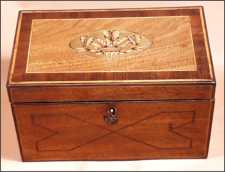 |
A very fine Georgian Tea Caddy veneered
in mahogany. The top has a fielded panel cross
banded with darker mahogany and edged in boxwood.
It is inlaid with an oval design of the Prince of
Wales feathers. The front has a geometric inlay
in rosewood. The caddy is 7.75 inches wide 4.5
deep and 4.5 tall.
|
 |
The caddy is in very good original condition
and has a working lock with key. The inside has
two lidded compartments. The lids are inlaid with
boxwood which continues the theme of the top
panel.
The facings are in alternative light boxwood
and dark wood. When closed two thin lines show on
the outside. This is an elegant solution which
avoids the opening showing a predominant line and
gives interest when the caddy is open.
|
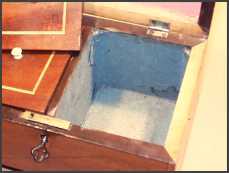 |
The inside of the compartments is lined
with grey blue paper which is 19th century. The
lids are not lined. The inside of the lid is
lined in original pink paper. It is very
likely the bottom part of the box was cleaned out
and relined some decades after it was first
made.
|
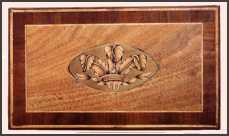 |
The top of the box has faded to a
beatiful mellow patina with a warm glow. It still
retains its wax finish. |
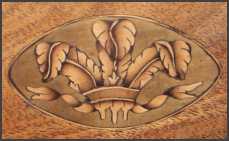 |
Detail of the inlay. NOTE the
background natural green of the inlay, which is
both uneven and faded to a subtle brown-green.
This is how genuine inlays from the 18th century
look. Note also the light and shade on the design
which was done by dipping the wood elements in
hot sand or lead. The caddy has escaped
inappropriate sanding and refinishing and the
inlay retains the tiny unevenesses of a genuine
antique. |
 |
These inlaid Georgian caddies are often faked
or ruined by refinishing. This enlargment is a
good example of a genuine inlay. Note the
colours. The green would only be bright on the
inside of a box if it had had no exposure to
light. Even then it would be uneven. It would not
look as if it has just been stained. I have
posted further information on
Fakes and Abuses on the web.
|
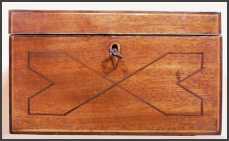 |
Front view showing the inlay and the
contrasting lines where the box closes. The
escutcheon is in an inverted tear drop shape
typical of the period.
The edgings in boxwood and dark wood continue on
all sides. |







